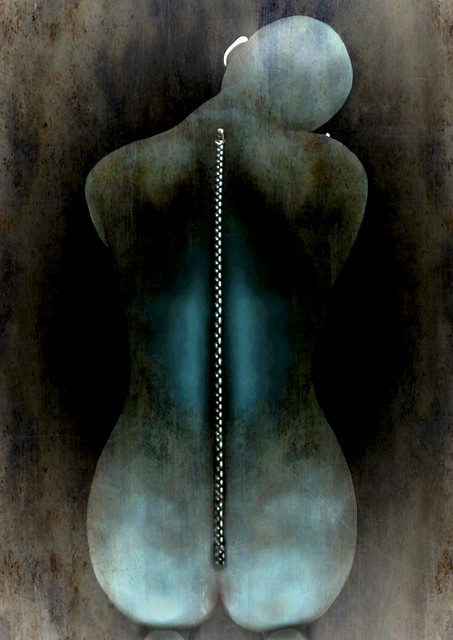 (Image by Del May used under CC 2.0 via)
(Image by Del May used under CC 2.0 via)
Back pain is one of the most common causes of sick leave in many Western countries. It is also one of the most common symptoms of achondroplastic dwarfism. The severe curvature of the spine coupled with innate hypotonia (i.e., low muscle tone) results in chronic pain from birth on, at times requiring back-braces and/or surgery to avoid debilitating complications.
I recall being younger than five-years-old, sitting cross-legged on the floor with a book and knowing I couldn’t stay like that for more than a minute or so before the aches would begin. I would usually end up slinking toward the sofa. In primary school I was exempted from sitting on the floor, given a chair with which to tower over my classmates during story-time. Years of physical therapy and orthopedic consultations have done little to alter this reality because the curvature is anatomic. Exercises and ergonomic furniture make the difference between utterly unbearable pain and merely lingering pain. At the end of a three-week stay in Tokyo, I wrote to my partner, “I will miss so many things about this city. Things I will be happy to come home to: couches, chairs with backs, toilets with seats, back support in general.”
A fascinating interview with architect Witold Rybczynski appearing last month in The Atlantic chronicled the history of the chair and the differences between cultures in which people primarily sit on chairs and those in which people, like the Japanese, primarily sit on the floor. The reason for the dichotomy continues to elude researchers:
You’d think, for example, that people in cold, wet climates would be more likely to sit on chairs, so as to avoid the unpleasant ground. But the Japanese, who endure frigid winters, have traditionally sat on floor mats, while the ancient Egyptians, who lived in a warm, dry climate, are thought to have invented the folding stool. Nor is chair-sitting necessarily a matter of lifestyle; some nomadic groups move about with collapsible furniture, while others don’t. Nor is it always a product of economic or technological advancement; the prosperous Japanese were long aware that people in other parts of the world sat on chairs—they just chose not to. Some societies, like China, have transitioned from being predominantly floor-sitting cultures to being predominantly chair-sitting cultures. Others, like India, idiosyncratically mix the two approaches.
California-based acupuncturist Esther Gokhale believes that members of most floor-sitting cultures do not suffer as much back pain as those of us in chair-sitting cultures. National Public Radio’s Goats and Soda program interviewed Gokhale in June about a series of exercises she developed—the Gokhale Method—intended to reshape the Western human spine and rid sufferers of back pain. Doctors in the San Francisco Bay area have been referring patients to Gokhale, and several celebrities have followed suit, despite that her method has not yet been clinically tested. Dr. Neeta Jain demands, “If people are finding things that are helpful, and it’s not causing any harm, then why do we have to wait for a trial?”
We should wait for many clinical trials because they would prove decisively whether or not the method is causing any invisible harm, and it would control for preexisting conditions like achondroplasia, cerebral palsy or lupus. While there is no proof that Gokhale’s method cannot lessen back pain for people with achondroplasia, there is also no proof that her one-size-fits-all approach cannot cause more pain or injury to people with achondroplasia as many exercises developed for average bodies can.
As a doctor, Jain is in a position of authority and she is acting irresponsibly when she fails to acknowledge the possibility of unforeseen risks. Perhaps she only refers her patients to Gokhale after screening them for potentially complicating factors, but her statement excludes such caution and instead serves as an advertising slogan.
Perhaps the greatest achievements of modern medicine has been its ability to serve not only the general population but those with rare and exceptionally complex conditions. Yet advice found in the health sections of any mainstream news source tends to overlook those of us with rare conditions and official disabilities. This is a truly ironic form of marginalization, since our lives have undoubtedly been far more affected by issues of health and medicine than the average reader. Going so far as to call it ableism seems extreme, since space is limited from a journalist’s point of view. But it is unfortunate that the best health advice for most people with disabilities is to ignore the mainstream health sources that ignore them.


Leave a comment